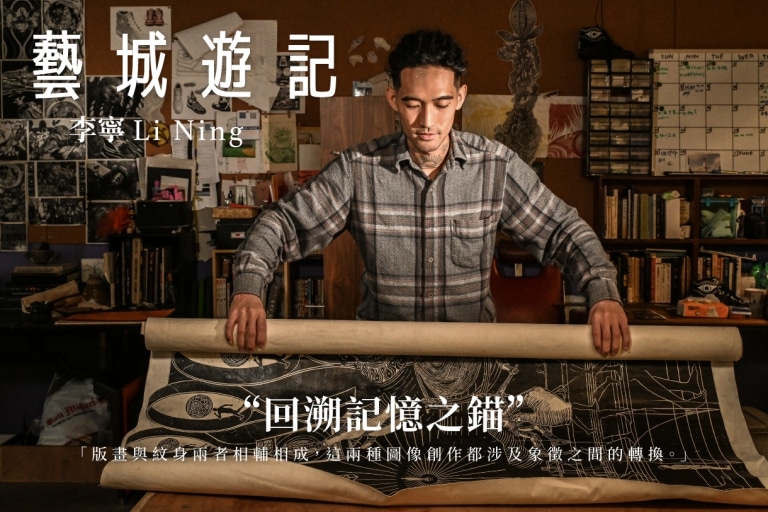Creation often stems from a single thought, and artists seize the moment of inspiration to apply paint and create. However, for printmakers, transforming inspiration into a complete image requires a series of steps, including drawing drafts, carving printing plates, applying ink, and pressing. Each creation is like an experiment, only revealing the final appearance of the finished product when the paper is unfolded. This slow and winding process also gives Li Ning the opportunity to organize his imaginative ideas and construct various science fiction visions on the flat paper.
As an artist and tattoo artist, Li Ning’s “canvas” includes not only linoleum but also living skin. In printmaking, Li Ning is accustomed to using relief techniques, which involve the use of “subtraction”. He carves away unwanted parts on the printing plate with carving tools, while the desired image is retained to become the inked position, ultimately creating a vivid relief print with distinct tones. On the other hand, tattoos involve injecting pigments into the body, adding exclusive symbols to clean skin, employing the technique of “addition” instead. Printmaking allows for multiple copies and is aimed at the public, while tattoos are unique body imprints. These seemingly different creative concepts, however, reveal subtle connections and even complement each other in terms of image transfer and line usage, supporting Li Ning’s imaginative ideas.
Whether it’s holding a carving knife or a tattoo needle, the moment of action requires extreme focus, as if time stands still. Today, we step into Li Ning’s studio, unfolding the scroll of time, capturing the moments of inspiration.
“I describe printmaking as very dominant.”
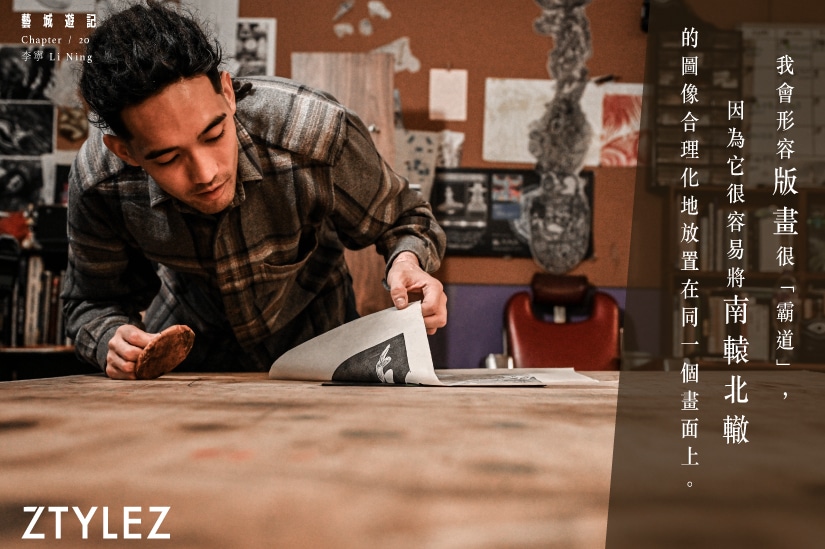
When the subconscious, dreams, imagination, and emotions intertwine, they naturally weave an infinite fantasy space. This is a unique attribute of printmaking, where you can juxtapose objects from different time and space and still create a complete image. Faced with such a medium, Li Ning believes: “Printmaking has the ability to rationalize and place contradictory images in the same point. I would describe it as domineering, because on the same pressure and plane, the printed images all become coherent.”
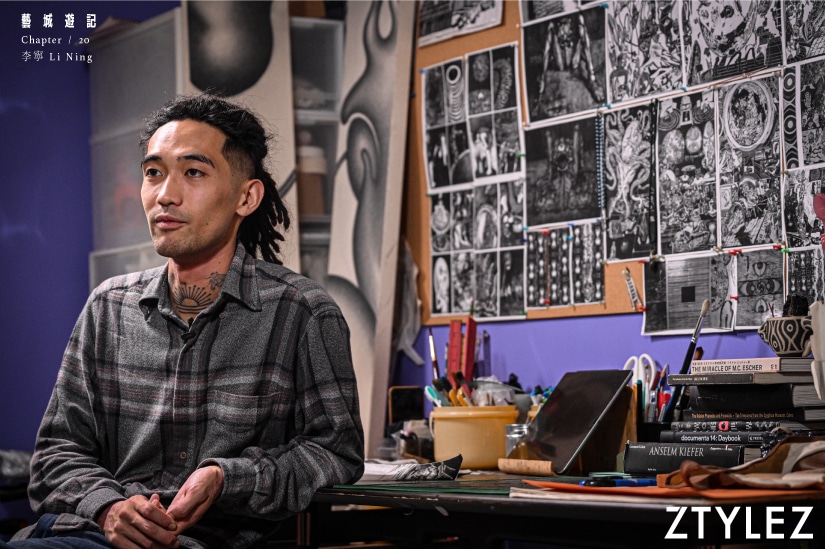
Deeply influenced by mysticism, spiritual philosophy, and science fiction stories, Li Ning’s prints are always filled with surreal images. In the same composition, we can see objects from different dimensions of time intertwined, narrating various stories full of metaphorical imagery. Li Ning says, “Actually, I am trying to find my own vision, which is to hope that everyone sees a whole page of comics, combining different events that happened at different points in time. I am thinking about how to capture everyone’s attention for a longer time, so I often contemplate various combinations in composition.”
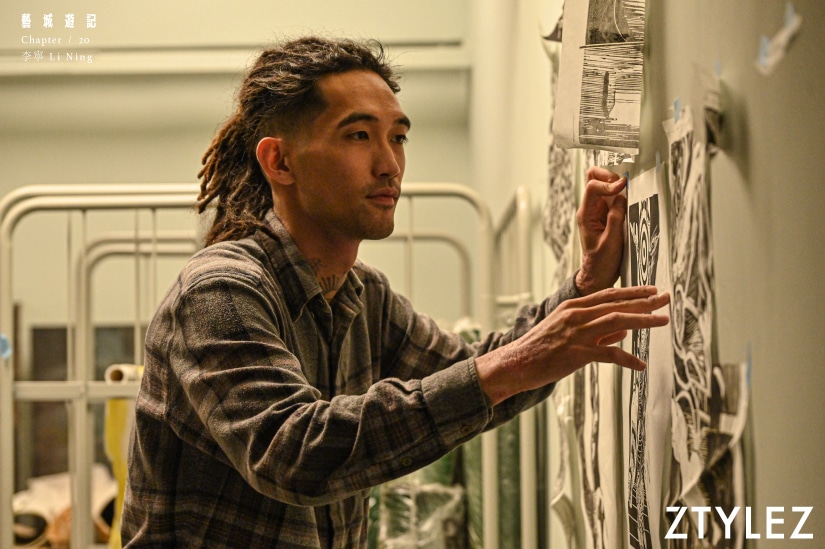
People may think that when he talks about “captivating the audience’s eyes,” he wants to prolong the time for the audience to contemplate the image. However, Li Ning hopes that everyone will see his work as a game. Besides enjoying the visuals, he also wants people to discover different ways of viewing the world. These unique narratives stem from the integration of the creator’s personal dreams and thoughts. Perhaps the stories are a bit surreal, floating between reality and illusion. But his intention is not to analyze the truth for everyone, but rather to encourage people to trace certain patterns about history or life from the stories. When faced with the current state of the world, one may realize that everything is just a cycle, and that sense of powerlessness towards the status quo will diminish.
“I am good at finding freshness.”
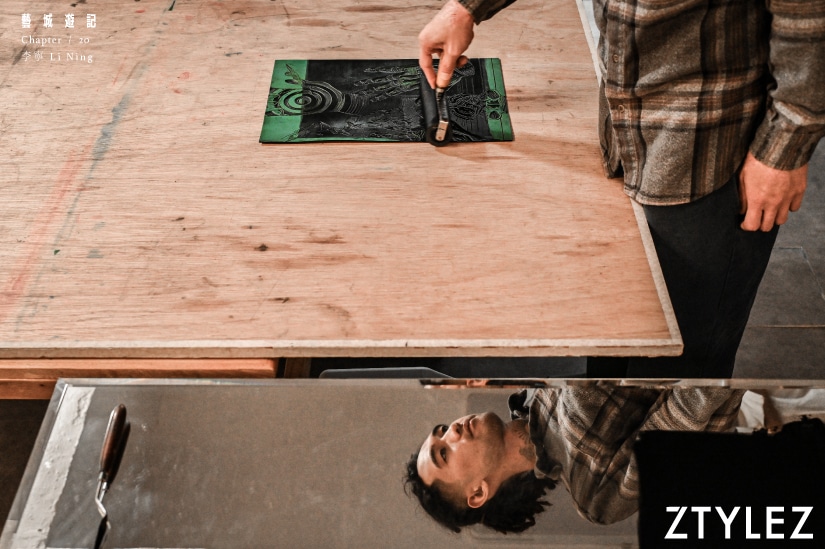
The print is full of densely woven narratives born from imagination, and in the interpretation of meaning, Li Ning deliberately leaves space for personal interpretation. When asked about the freshness that creation brings him, Li Ning admits that he is always in a state of ups and downs. He jokes, “When I feel bored, I try to find something new to look at. When I can’t find it, I feel depressed. When I find it, I get excited. I have accepted this kind of emotional roller coaster.” Whether it’s printmaking or tattooing, both processes require long periods of focus. He often listens to strange stories from all over the world on internet radio programs, absorbing many theories beyond his own understanding, which inspires his creative inspiration.
“Printmaking and tattoos complement each other.”
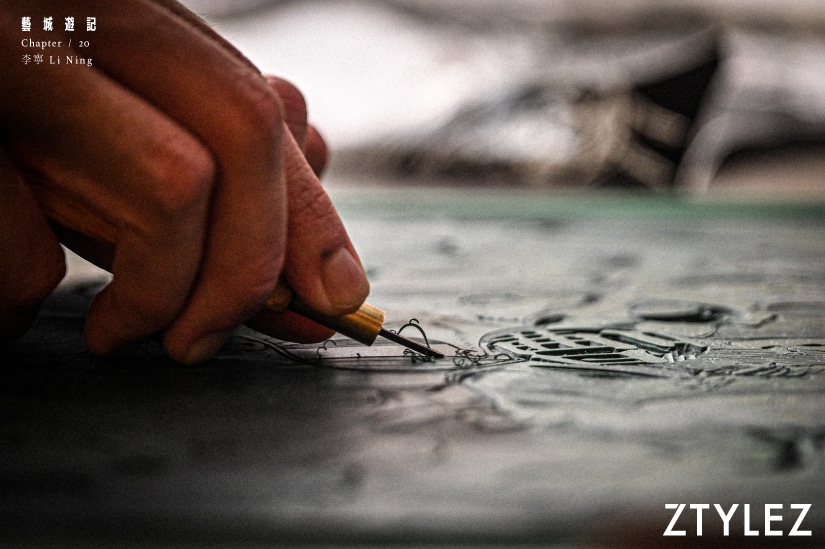
Looking back on the reasons for getting into printmaking, it turns out that it is also related to tattoos. Li Ning shared that he had the idea of becoming a tattoo artist since he was young. For a period of time, in order to expand his tattoo library, he crazily drew tattoo flash and covered the walls of his studio with them, which also resulted in his paintings at that time being filled with dense lines. Later, his teacher at the time suggested that he reduce the elements in his compositions. So Li Ning became more involved in printmaking, using the process of removing surface parts to compose, and eliminating unnecessary brushstrokes. The excess lines gradually decreased, but his love for printmaking grew day by day, and it has continued to this day. As printmaking and tattoos developed side by side, we are all curious about the relationship between the two, and how he balances the two creative methods.
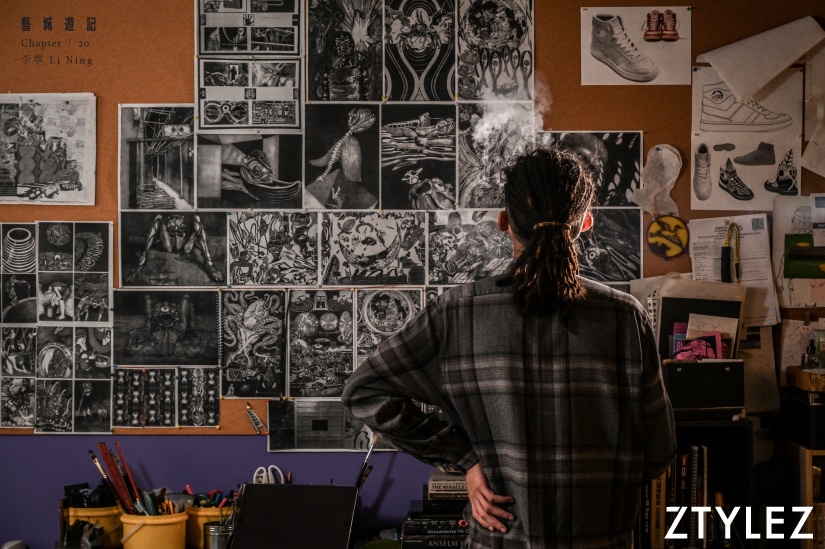
Li Ning said that printmaking and tattoos have always been closely intertwined. When making relief prints, his method is to print the plate material on washi paper, and then collage different patterns on the canvas. This is very similar to the transfer technique used in tattoos. And since printmaking covers a larger area, it’s like combining tattoo images together.
“A tattoo is like dropping an ‘anchor’ of a memory.”
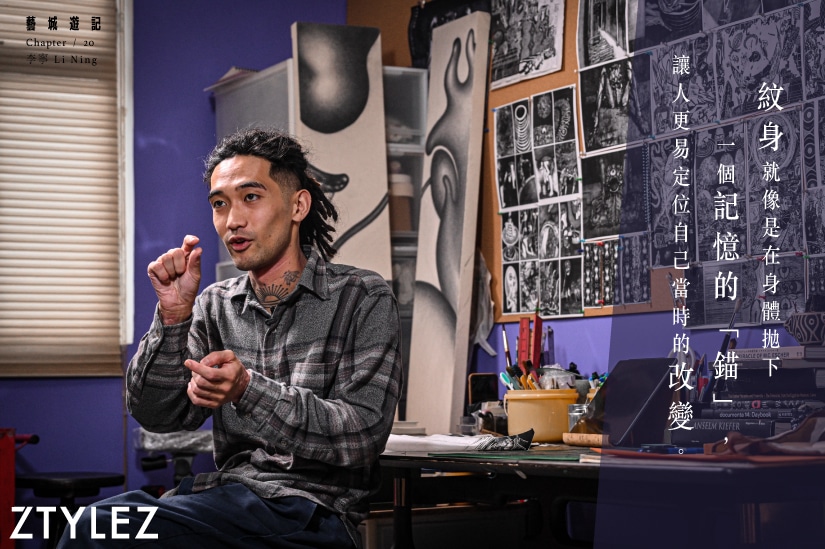
From self-taught tattooing, he even used his own skin as an experiment. Now, after ten years, Li Ning has become one of the popular local tattoo artists. Using human skin as a canvas, once the ink is injected, the design becomes irreversible. What does tattooing mean to him?
Li Ning shared: “I think it’s cool to leave some marks on the skin, it’s not something that can be easily changed. Even when you paint, you choose materials, and I think ‘human skin’ is already very extreme as a material. Human skin is alive, and the way your work is displayed in the world is so unique. It exists on top of a living being, and all these concepts are very appealing to me.”
It is precisely because of the irreversible nature of tattoos and the intense sensations they bring to the body that give this action more meaning. Rather than simply adding a design to the body, Li Ning sees it as a ritual. He says, “If humans break through a few things, they will become different, and pain is one of them. Pain not only stays in your mind, but also belongs to the physical memory. The moment of getting a tattoo is like dropping an ‘anchor’ of a memory, making it easier for you to locate the point where you changed later on.” Because the pain endured in the process is not light, those who want tattoos often accompany it with a determination to change. This “anchor” is the original intention, and it may also be a symbol of growth, allowing people to not lose themselves in a certain stage.
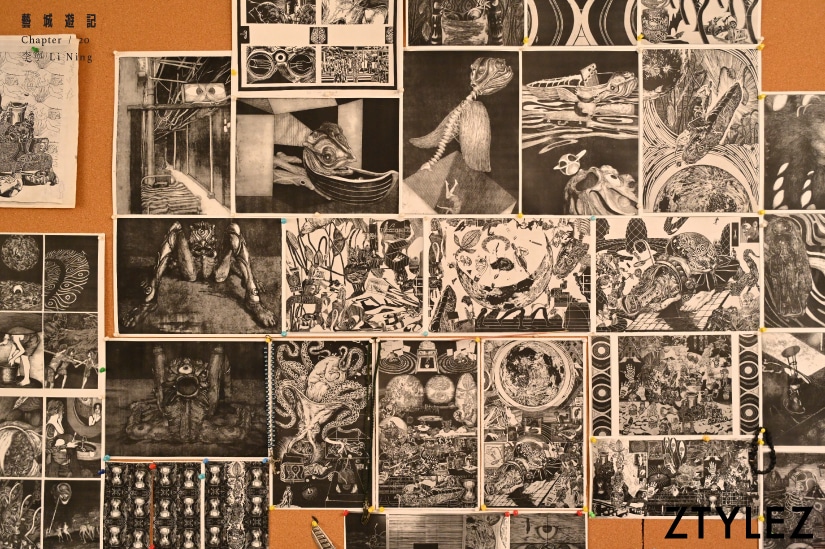
When interest becomes a profession, Li Ning still gets excited when talking about tattoos. Although he didn’t receive any formal tattoo guidance at the beginning, he tried being tattooed by others and even tried tattooing himself. Some techniques were discovered through trial and error. Every day brings unexpected surprises, which is also his tireless motivation.
And more importantly, tattoos are not just a job, but also an opportunity for creation. Li Ning’s tattoo style tends to be more customized. Many times, customers will give him some references, which could be photos, text, sound, or a certain feeling. He will then transform what the customer has given him into a unique image. Customers entrust their personal emotions, and the artist responds with their craftsmanship. In this process, trust is exchanged, and it is carried out on a living human body. He says, “Tattoos are a way for me to entrust something to you, and you have to trust me in return. We can only give each other a lot of trust, and this connection is still very effective until now.”
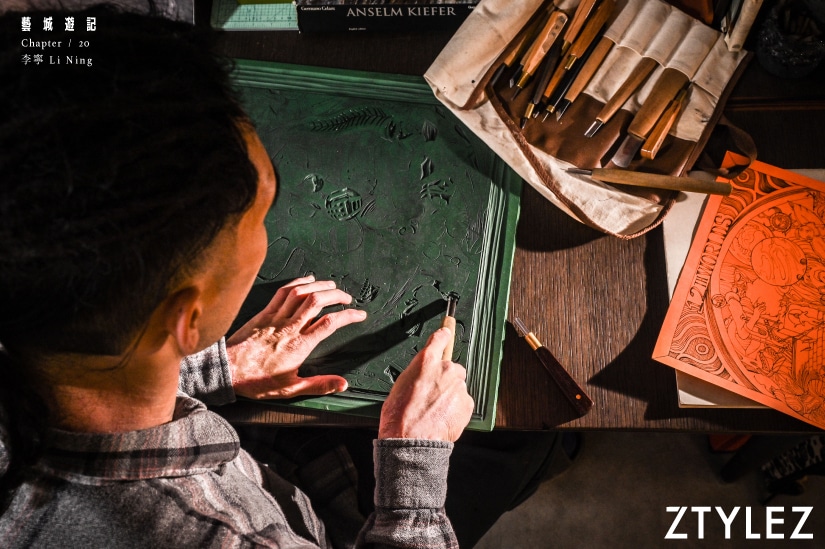
“The ‘art’ of art is how you handle the techniques of the external world.”
Everyone has a different definition of contemporary art, and there are no clear guidelines for any form of creation. So what kind of work can be considered superior? For Li Ning, whether it’s printmaking or tattoos, it all started with self-study. Instead of focusing on systematic technical performance, he is more concerned with the intellectual value that his works present.
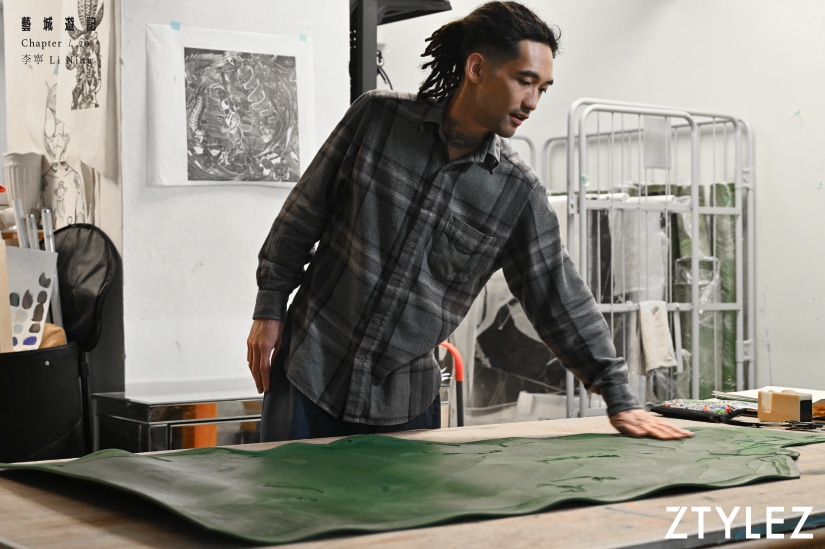
He shared, “The works that I personally like are those that focus on the creator’s personal perspective. Having a perspective is very important. At different times, I have been thinking about the value of artistic works. When I was young, I may have paid more attention to the technical aspects of the performance, but later on, I gradually felt the effort that creators put into their ideas through their works. Sometimes, creation gives you a reason to go out and do some research and understand your own thoughts, and that process will change your worldview.”
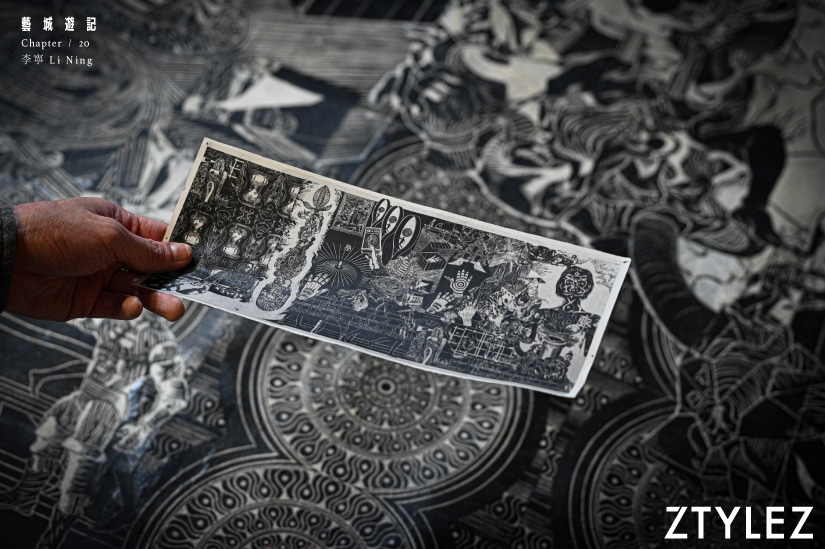
Li Ning’s prints are filled with intricate lines, creating a rich visual composition. When different elements come together, the audience feels like they are entering a world of infinite possibilities. The artist transforms the texts and images absorbed from daily life into visual representations, which are applicable to both tattoos and prints. He claims that his creative process has trained him to excel in the conversion of symbols. Whether it’s on paper or on skin, the totems are simplified and refined. How to respond to the world doesn’t necessarily require concrete actions, but rather how you interpret and express yourself in your own way after absorbing all the information given to you by the outside world.
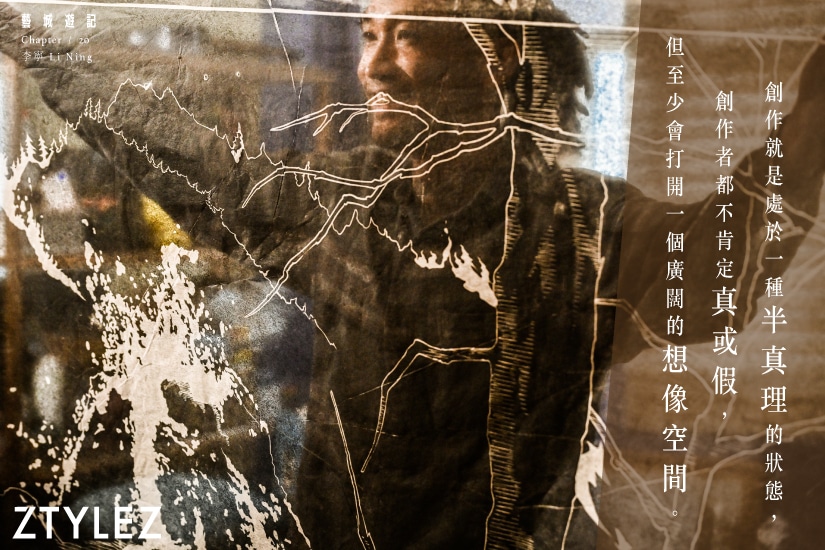
He said, “Creation is in a state of semi-truth. Because creators are not sure of the authenticity of such things, but at least they make them first. Creation often contains an element of provocation, because it opens up a wide space for imagination and then sees how everyone can fit into it.” In this way, the work is no longer just a reflection of the creator’s inner self, but also connects with the viewers and the era in an intangible way.
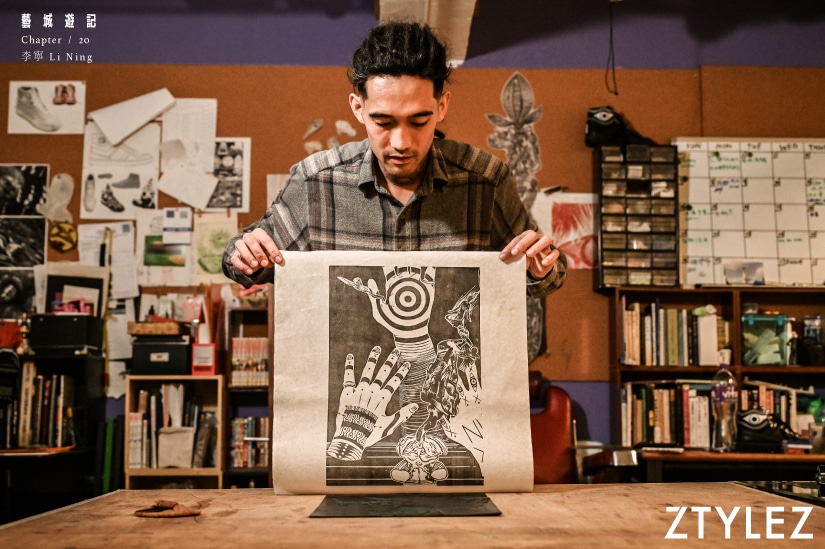
“I feel quite lucky that I entered the field of printmaking or tattoo art during a period of changing values.”
Although everyone has a basic understanding of printmaking and tattoos, they may not be the most popular forms of artistic expression. Li Ning navigates between these two creative mediums with an optimistic attitude. In terms of tattoos, people in the past may have held a conservative attitude towards them. However, for people today, tattoos hold a variety of meanings. Some people seek a spiritual belief through the pain that comes with damaging their bodies, while others hope to trace the turning points in their lives through the tattoos that accompany them throughout their lives. He openly states, “Nowadays, everyone has gained a greater appreciation for the value that can be obtained from tattoos.”
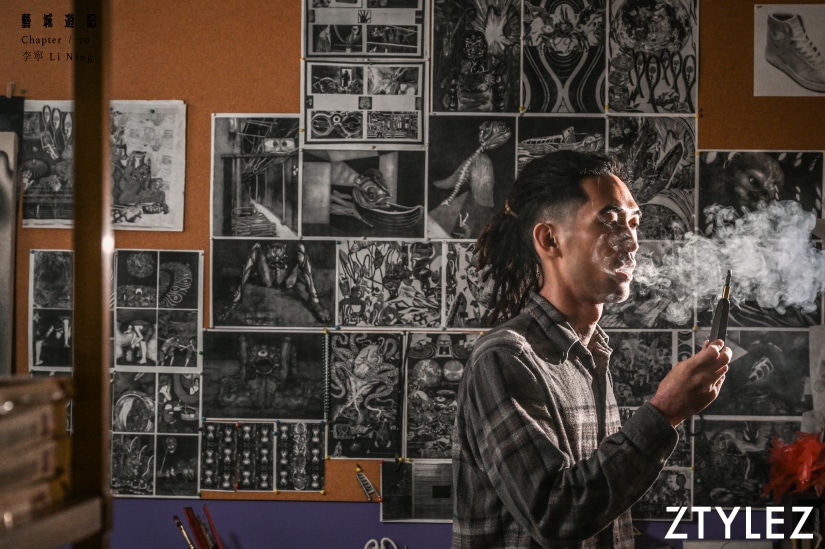
And in terms of printmaking, he feels that the art scene in Hong Kong has shown a significant increase in attention towards printmaking. Upon reexamining the functionality of this medium, Li Ning believes that printmaking itself carries a kind of “inspiring” characteristic. Artists carve images onto printing plates and can then reproduce them multiple times, effectively increasing the dissemination of their works. If the images can evoke certain meanings, resonate with the times, and echo within the viewer’s heart, then it becomes even more precious. Li Ning jokingly says that creating art allows you to gain a different kind of “voice”, which is not about wanting to express truth or shake the world, but rather a sincere sharing in the realm of visual art.
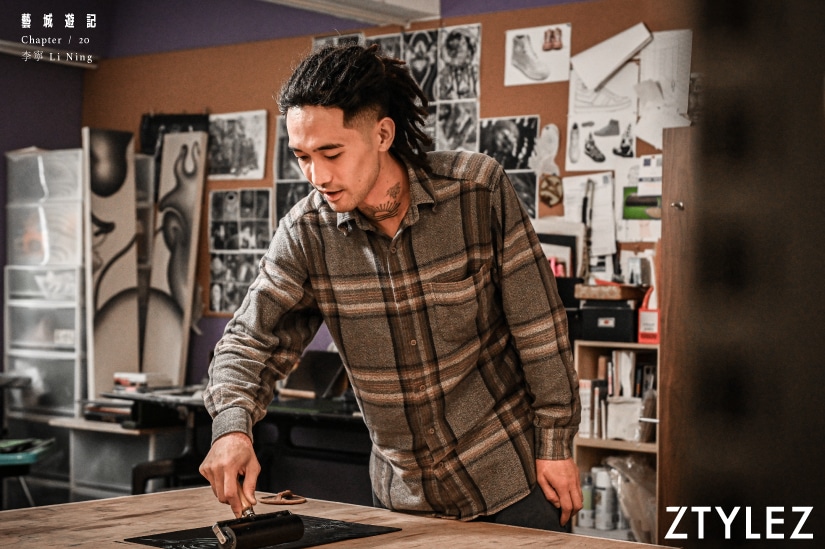
The creative journey is full of twists and turns, with the constant presence of visual lines and the cycles of inspiration. Whether it’s materials or skin, all a creator can do is leave behind the mark of the present moment with their own hands, anchoring memories for you. How you define the meaning of that moment in time is up to you, allowing you to reflect and savor it slowly.
Executive Producer: Angus Mok
Producer: Mimi Kong
Editor: Ruby Yiu
Videographer: Alvin Kong, Kason Tam
Video Editor: Alvin Kong
Photographer: Ken Yeung
Designer: Michael Choi
Special Thanks: Li Ning

